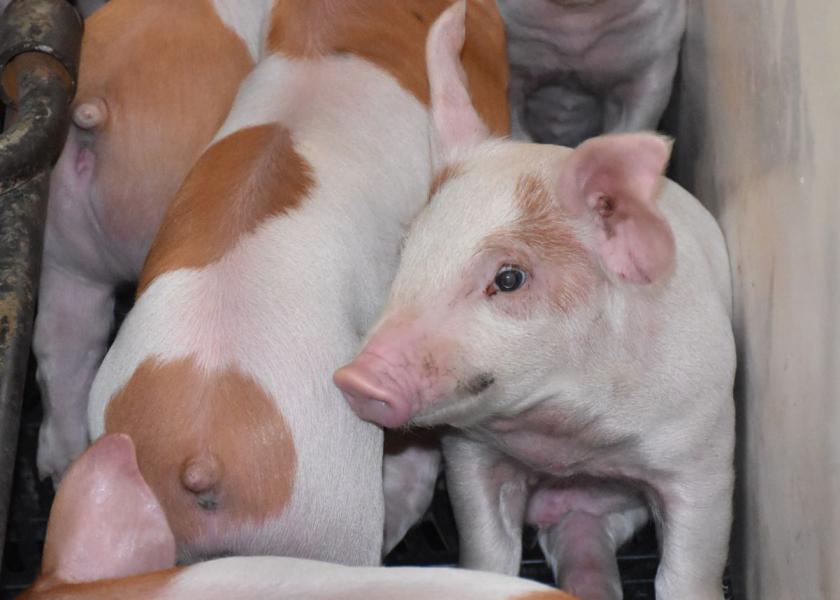It’s Time to Unravel How Multiple Swine Pathogens Interact in the Pig

It’s one thing to know how a disease pathogen affects a pig. It’s another thing to know how multiple disease pathogens affect a pig.
“There's a lack of understanding of the interaction between enteric and respiratory pathogens,” Fernando Leite, technical manager for enteric diseases at Boehringer Ingelheim Animal Health, explained during an Industrial Partner Session at the American Association of Swine Veterinarians annual meeting in Nashville. “Multiple pathogens can affect swine, yet there hasn't been a field evaluation of enteric and respiratory pathogen challenges together to better understand their consequences.”
That’s what led Leite and Guilherme Cezar, graduate research assistant at Iowa State University, to conduct the Dynamic Pig Health Project – aimed at understanding swine health and the consequences of pathogen challenges better.
“We are always thinking about how we can help veterinarians and producers the best we can in the industry. Fundamentally, we realize there's a lack of investigations and understanding of pathogens as a whole, their interactions, affecting swine and swine populations,” Leite says.
Finding Practical Answers in the Field
Cezar says the beauty of the Dynamic Pig Health Project is that it was conducted in a real-world setting, following the pig around from weaning to market. Along the way, Cezar and his team collected samples of oral fluids from 40,000 pigs. From those samples,12,000 PCRs were performed.
“We could test for all these pathogens that were specific to porcine reproductive and respiratory syndrome (PRRS) and Lawsonia. Then, we evaluated their interaction in the field, in conditions that are a reality for the producer,” Cezar explains.
All of the pigs in this project were negative for PRRS when they entered the production system. Along the way, the pigs got PRRS. One of the key findings of this project was when they did get PRRS, all the groups that had low average daily gain and higher mortality also had higher detection of Lawsonia in their oral fluids as well.
This held true for porcine circovirus 2 (PCV2), too. The groups that had a higher incidence of PCV2 compared with the others also had the higher amount of Lawsonia in terms of PCR detection.
“This is a unique study,” Leite says. “This interaction of Lawsonia with PRRS and PCV2 hasn’t been done before. It also took place in the field, not a lab. I think it's the first time that these interactions have been unraveled.”
He says he wasn’t surprised that when these pathogens occur in a real-world setting, they often occur together.
“Lawsonia infects the ileum, which is the primary site of nutrient absorption,” Leite says. “One of the things I would highlight as it regards to Lawsonia is that mortality wasn't attributed to Lawsonia. There wasn't clinical diarrhea that was observed due to Lawsonia. So, if it were not for this particular project and investigation, this interaction probably wouldn't be known.”
Why is This Connection to Lawsonia Significant?
All too often, producers and veterinarians don’t understand the variability of why one herd has higher mortality with PRRS and PCV2 than another.
“This is a new variable for us to consider. It’s something else to target and it's something else to think about when we're trying to optimize pig herds that are susceptible and are exposed to the PRRS virus,” Leite explains.
One of the main takeaways for Cezar is that the individual pathogen approach that farms usually take may not be the best approach.
“Sometimes multiple pathogens are influencing your mortality and your average daily gain. So when you look at it, there’s multiple patterns going on,” Cezar says. “It's better for producers to deal with all of them, and not only one.”
Leite believes a better understanding of these interactions will allow researchers to come up with different interventions and controls that hadn't been thought of before.
Why Should Producers Care?
“It really changes the way we ought to think about health,” Leite says. “PRRS is an extremely important pathogen. What the research leads you to believe and has shown with statistical significance, is that there are other pathogens that we wouldn't think of before like Lawsonia, that are associated with mortality.”
The benefit to producers is knowing Lawsonia is a variable to consider when dealing with diseases like PRRS and PCV2.
In the future, Leite hopes the Dynamic Pig Health Project leads to better understanding and better characterization of the economic impacts of these pathogens as they occur in the field. Hopefully, it will lead to the development of different management strategies.
“Don’t forget that Lawsonia and other pathogens are not only controlled with vaccines, but they also benefit from sanitation and biosecurity,” Leite says. “We can't think about pathogens on their own. There are interactions that we ought to think about to really optimize health as a whole and production performance.”
Read More:
Post-Weaning Scours: No One-Size-Fits-All Solution







